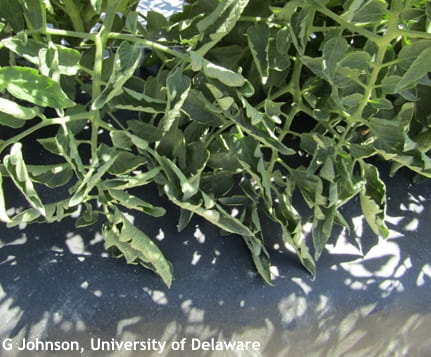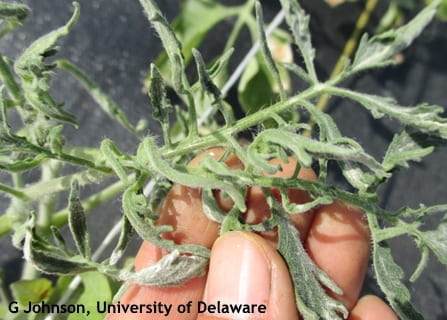Gordon Johnson, Extension Vegetable & Fruit Specialist; gcjohn@udel.edu
Leaf curling, cupping, and rolling in vegetables can be caused by virus diseases, aphid infestations, herbicides and growth regulators. We are currently finding physiological leaf roll and leaf curling due to exposure to growth regulator herbicides in vegetable fields. It is important to know how to distinguish between the two.
Physiological Leaf Roll
Late spring and early summer is the time of the year that we often see leaf cupping and rolling disorders appear in vegetable crops that are not related to pests or chemicals. This can be seen in tomatoes, peppers, potatoes, watermelons, beans, and other crops. This is a physiological disorder that may have many contributing factors.
In tomatoes, leaf roll starts at the margins which turn up, then roll inward, most commonly on the lower leaves. Upward cupping is also found commonly in watermelons and potatoes. Beans, peppers, and other vegetables may cup downwards. Leaves may stay in this rolled or cupped state for a short period of time and then return to normal, or they may remain permanently rolled or cupped. Rolled leaves may become thicker but are otherwise normal. Physiological leaf roll or cupping is often variety dependent with some varieties being more susceptible than others.
There are several possible causal factors for physiological leaf roll or cupping. Water relations are suspected in many cases where there has been a reduction in water uptake or increased water demand placed on the plant. The plant responds by rolling the leaves which reduces the surface area exposed to high radiation. High temperatures, excessive pruning, cultivation, and vine moving activities may also trigger leaf rolling. High nitrogen fertility programs followed by moisture stress may also trigger this type of leaf roll. Inadequate calcium moving to leaf margins may also cause a different type of leaf cupping. This is also related to interrupted water movement.
In most cases, yields are not affected by physiological leaf rolling or cupping. However, growers may choose to select varieties that are less susceptible to this disorder.

Physiological leaf curl on tomato
Growth Regulator Herbicide Damage
Growth regulator herbicides are often of most concern for drift damage to vegetable crops. This group includes dicamba, 2,4-D, MCPA, MCPP, triclopyr, picloram, clopyralid, aminopyralid, and quinclorac. These herbicides can drift over one mile from where they were applied when volatilized.
Symptoms include leaves becoming cupped, crinkled, puckered, strap-shaped, stunted, and malformed. Leaf veins can appear parallel rather than netted, and stems become bent, twisted, and brittle.
When compared to physiological leaf roll, growth regulator herbicide injury symptoms will be concentrated on the upper part of the plant (growing points), the leaf veins will be affected showing a parallel pattern, and stems may be twisted – none of these symptoms will be present in physiological leaf roll.

Growth regulator herbicide damage on tomato. Note leaf cupping, strapping, twisting, and unusual vein pattern.
